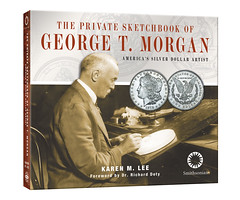
PREV ARTICLE
NEXT ARTICLE
FULL ISSUE
PREV FULL ISSUE
BOOK REVIEW: THE PRIVATE SKETCHBOOK OF GEORGE T. MORGAN
First, the hobby owes many thanks to the Stack Family, Jeff Garrett, and author Karen Lee for rescuing Morgan's sketchbook from obscurity and fleshing out his life story for today's readers. These events are summarized nicely in the book's Foreword by Dick Doty, Sr. Curator of Numismatics at the Smithsonian Institution, where the sketchbook resides today.
Writing a book is never easy, but writing this one would have been much easier had the author chosen simply to reproduce Morgan's sketches along with some annotation. But as noted in Doty's Foreword, Karen Lee used the sketchbook as a launching pad for researching the artist's entire life and career, and the result is an important contribution to the body of numismatic knowledge. The first chapter delves into Morgan's early life and surroundings from his birth in Bilston (near Birmingham, England) in 1845. Times were tough - Morgan's father ended up in debtor's prison. Young George found work as a die sinker at the age of fourteen. He attended the Birmingham School of Art at night from 1861 to 1867, then found his way to London and was mentored by Leonard Charles Wyon, whose family had designed many of Britain's important coins and medals. From 1873 to 1875 Morgan worked for John Pinches, another prominent British envgraver and medallist. There's a lot of great information for collectors here, especially for those who delve beyond the mere accumulation of a series by date and mintmark. Here are found many of Morgan's early medals, which would make a fine collection by themselves and a perfect companion to an exhibit of his famous U.S. dollar coins. Examples include Morgan's 1872 Portrait medal of Francis Fowke and his 1876 Art and Labor medal. Following an exchange of letters and recommendations initiated by U.S. Mint Director Linderman, George Morgan arrived in Philadelphia on October 7, 1876 to begin an apprenticeship that would lead to his lifelong career at the U.S. Mint. Morgan's sketchbook contains designs for a number of proposed and actual coins and medals, both for the U.S. Mint and private commissions. This paragraph provides a glimpse into the knowledgable commentary on Morgan's skills seen throughout the book (p46): "Morgan was also expert at sfumto gradation. This technique - when judiciously applied - allows an artist to create texture and depth on flat surfaces. What today can be instantly accomplished with a single click on a computer, Morgan practiced years to master. The ability to nuance and manipulate visual perception, especially on a miniature scale, is what set him apart from his U.S. Mint colleagues." I didn't do it this time, but I generally approach a new book from back to front, for often the best parts for a researcher are found there. A good bibliography, notes and appendices are what make a book most useful to both readers and future researchers. The Morgan Sketchbook did not disappoint. Appendix A is a catalog of Morgan's American numismatic works, including coins, patterns, medals, decorations, badges, galvano casts and other items. It's a lengthy, detailed and impressive compilation that could well serve as a blueprint for a book of its own. Appendix B contains selected illustrations of Morgan's American numismatic works, shown in color at actual size. Impressive! Appendix C is a gallery of images of selected primary source documents including correspondence between U.S. Mint Director Henry Linderman and Charles Fremantle, deputy Master of the British Royal Mint. While I would have enjoyed seeing more comprehensive appendices that included Morgan's non-American work, that was probably beyond the intended scope of this work. Karen Lee's first book is a masterful one, and I hope we'll see more of her numismatic writing in the future. We'll have an opportunity in 2015 - she and her team are working on a new gallery of numismatics to open at the National Museum of American History.
To read the earlier E-Sylum article, see:
NEW BOOK: THE PRIVATE SKETCHBOOK OF GEORGE T. MORGAN
(www.coinbooks.org/esylum_v15n41a04.html)
The Numismatic Bibliomania Society is a non-profit organization promoting numismatic literature. See our web site at coinbooks.org. To submit items for publication in The E-Sylum, write to the Editor at this address: whomren@gmail.com To subscribe go to: https://my.binhost.com/lists/listinfo/esylum All Rights Reserved. NBS Home Page Contact the NBS webmaster 
|
